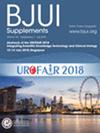使用镓- 68 - N188 PET/CT用Nectin - 4显像分期转移性尿路上皮癌
IF 4.4
2区 医学
Q1 UROLOGY & NEPHROLOGY
引用次数: 0
摘要
目的利用Nectin‐4结合肽镓‐68‐N188和正电子发射断层扫描(PET)/计算机断层扫描(CT),量化晚期或转移性尿路上皮癌患者肿瘤病变中Nectin‐4的表达,这些患者符合使用Nectin‐4导向的抗体-药物偶联物enfortumab vedotin联合检查点抑制剂pembrolizumab (Ev/P)治疗的条件。方法在10例患者中,根据标准化摄取值(SUV)测量,在计划全身治疗前分析Nectin - 4 PET/CT成像,并将结果与Nectin - 4免疫组织化学显微镜检查结果和临床随访相关联。结果Nectin‐4 PET适用于检测肿瘤病变中Nectin‐4的表达,并显示了Nectin‐4表达的异质性-例如,在淋巴结转移和器官转移之间。因此,PET成像的Nectin‐4表达是一种潜在的临床相关方法,用于管理Nectin‐4靶向治疗的应用。结论:作为一个原理证明,我们可以通过成像检测到Nectin - 4的表达,并将其作为尿路上皮癌靶向治疗的创新生物标志物。Nectin - 4在转移部位的个体内异质表达是常见的。本文章由计算机程序翻译,如有差异,请以英文原文为准。
Staging metastatic urothelial cancer with Nectin‐4 imaging using Gallium‐68‐N188 PET/CT
ObjectiveTo quantify Nectin‐4 expression in tumour lesions using the Nectin‐4‐binding peptide Gallium‐68‐N188 and positron emission tomography (PET)/computed tomography (CT) in patients with advanced or metastasised urothelial cancer eligible for therapy with the Nectin‐4‐directed antibody–drug conjugate enfortumab vedotin, in combination with checkpoint inhibitor pembrolizumab (Ev/P).MethodsIn 10 patients, Nectin‐4 PET/CT imaging was analysed before planned systemic therapy with Ev/P based on standardised uptake value (SUV) measurements and the results were correlated to available microscopic findings on Nectin‐4 immunohistochemistry and to clinical follow‐up.ResultsNectin‐4 PET is suitable for detecting Nectin‐4 expression in tumour lesions and demonstrates heterogeneity in Nectin‐4 expression – for example, between lymph node metastases and organ metastases. PET imaging of Nectin‐4 expression is therefore a potentially clinically relevant method for managing the application of Nectin‐4‐targeted therapies.ConclusionsWe show, as a proof of principle, that Nectin‐4 expression can be detected on imaging and serves as an innovative biomarker for targeted therapy in urothelial cancer. Intra‐individual heterogeneous expression of Nectin‐4 in metastatic sites is frequent.
求助全文
通过发布文献求助,成功后即可免费获取论文全文。
去求助
来源期刊

BJU International
医学-泌尿学与肾脏学
CiteScore
9.10
自引率
4.40%
发文量
262
审稿时长
1 months
期刊介绍:
BJUI is one of the most highly respected medical journals in the world, with a truly international range of published papers and appeal. Every issue gives invaluable practical information in the form of original articles, reviews, comments, surgical education articles, and translational science articles in the field of urology. BJUI employs topical sections, and is in full colour, making it easier to browse or search for something specific.
 求助内容:
求助内容: 应助结果提醒方式:
应助结果提醒方式:


